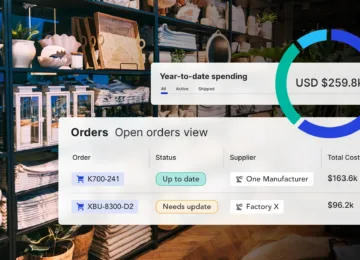Speed, efficiency, and accuracy have never been more important for businesses. In this increasingly competitive and often unpredictable landscape, organizations’ success has become almost entirely reliant on their ability to gather and act on data.
As such, enterprise resource planning (ERP) systems have become a critical tool. ERPs like NetSuite and Microsoft Dynamics help organizations manage a wide range of day-to-day business activities such as accounting, procurement, project management, and risk management and compliance. Many businesses call their ERP their “single source of truth”, referring to its benefits as a powerful data hub that allows you to collect, store, and analyze data in one centralized location.
As important as your ERP is, it isn’t always the easiest for other technology to plug into and can be somewhat cumbersome for other parts of the organization, especially supply chain teams.
Your ERP is Your First Building Block for Supply Chain Management
There’s no doubting it; an ERP is essential for the efficient running of your business. You can’t expect to be competitive in the long term if you’re stuck on manually merging data from several different systems.
But when it comes to supply chain management, it’s important to think of your ERP as your first building block. This is because, on their own, ERPs are simply not optimized for supply chains. Because of that, it’s important to supplement your ERP’s capabilities with additional tools and software that are specialized and built specifically to handle different areas of the supply chain.
This is where Anvyl comes in. We integrate with your ERP to close the gap between your global teams, your suppliers, and your supply chain tech stack. For example, we bring full transparency to your entire supply chain – from purchase orders with your supplier through delivery to your warehouse. This means we essentially open the door to end-to-end visibility, frictionless collaboration, and an intelligence layer that enables smarter decision-making.
In other words, we help you strengthen your ERP’s capabilities so that it truly is your single source of truth. With that in mind, let’s take a look at one of the most important use cases for your ERP – boosting your forecasting capabilities to add predictability into your supply chain.
Injecting a Dose of Predictability into Your Supply Chain
The supply chain has always had some level of unpredictability. But it’s fair to say that supply chain challenges like inflation, materials and labor shortages, and shipping delays have exacerbated this in a dramatic fashion.
According to our proprietary data, 45% of POs shipped late in 2022. Of these delayed shipments, 75% faced delays of over a week, 56% faced delays longer than 2 weeks, and 13% were delayed by more than 60 days.
Of course, no ERP or integrated partner can solve the myriad of economic complexities that cause these delays. But they can help you predict and manage supply chain pressures, like demand, delivery times, transportation costs, and other challenges. These are capabilities that are especially attractive to small and midsize businesses (SMBs), which don’t have the same luxuries as larger companies that often employ economists to monitor and forecast such disruptions.
Indeed, the past few years have been particularly harsh on SMBs. As a result of the Covid-19 pandemic, they first had to deal with the abrupt shutdown of manufacturing, which caused mass unemployment, product shortages, and operational losses. But even when consumer consumption patterns returned and triggered a surge in demand for certain items, many organizations didn’t have the resources to keep up.
By pairing their ERP with supply chain management software, SMBs can plan for these potentially fatal disruptions. In fact, according to Capterra, 67% of SMBs say their forecasting techniques have helped them avoid common supply chain impediments like inventory issues.
But this type of integration can also help you be more forward-thinking with your business forecasting. For example, in addition to using supply chain technology to predict things like inventory management issues or future product demand, you can use it to be a lot more prescriptive about how you grow your business. One example of this is using your forecasting data to solve persistent problems and inform collaborations for maximum effect, like optimizing the lead time and manufacturers you use to build out a leaner supply chain.
Creating a More Efficient Supply Chain
As businesses seek new ways to streamline their workflows and increase profitability, ERPs are skyrocketing in value. But in order to reap the full benefits of your ERP as your single source of truth, it’s crucial to combine it with the capabilities of a supply chain management technology.
At Anvyl, we focus on providing a supply chain management system that helps you improve supplier relationships, streamline your important business practices, and monitor and manage your global supply chain. Get a demo of our product today to discover how we can help bring your business processes to the next level.



